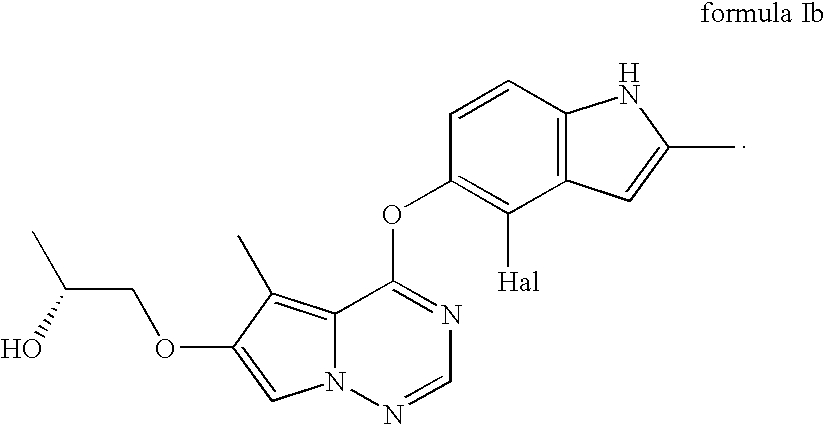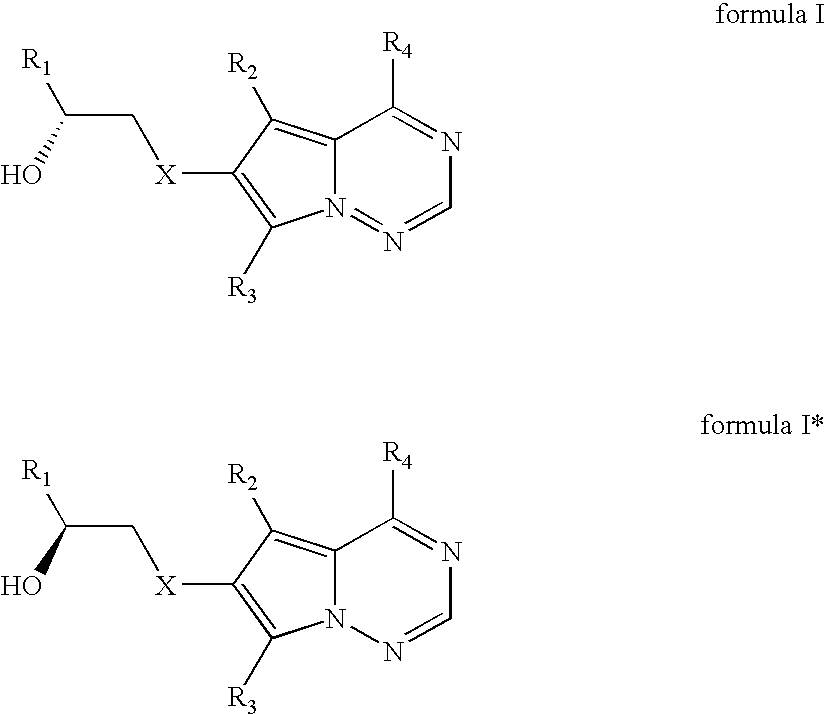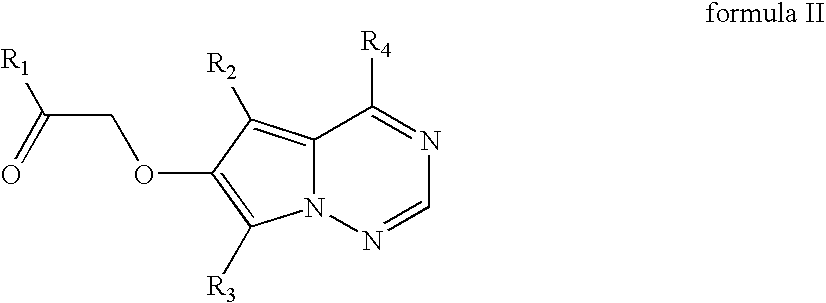Stereoselective reduction process for the preparation of pyrrolotriazine compounds
a pyrrolotriazine and selective reduction technology, applied in the field of selective reduction process for the preparation of pyrrolotriazine compounds, can solve the problems of difficult prediction of absolute configuration of product(s) or, in particular, the likely excess of enantiomerics, and achieve the effect of maintaining oxidoreductase activity
- Summary
- Abstract
- Description
- Claims
- Application Information
AI Technical Summary
Problems solved by technology
Method used
Image
Examples
example 1
1-[4-(4-Fluoro-2-methyl-1H-indol-5-yloxy)-5-methyl-pyrrolo[2,1-f][1,2,4]triazin-6-yloxy]-propan-2-one
[0111]
[0112] Preparation: A solution of potassium 4-(4-fluoro-2-methyl-1H-indol-5-yloxy)-5-methyl-pyrrolo[2,1-f][1,2,4]triazin-6-olate (126.13 mmoles; 50.00 g) in dimethylformamide (200 mL), prepared from 4-(4-fluoro-2-methyl-1H-indol-5-yloxy)-5-methyl-pyrrolo[2,1-f][1,2,4]triazin-6-ol with one equivalent of 25% potassium methoxide in methanol, was stirred at room temperature for 1-2 h. This solution was added slowly over 2 h to a mixture of chloroacetone (214.42 mmoles; 17.40 mL), potassium carbonate (63.06 mmoles; 8.80 g) and dimethylformamide (100 mL). Stirring continued for another 15 h at room temperature and 300 mL of water was added slowly over 20 minutes, ˜10° C. exotherm was observed. The slurry was cooled to 15° C. and filtered after 1 h. The filter cake was washed with 200 mL of 2:1 water-DMF mixture followed by 200 mL water. The wet cake was dried at 50° C. in a vacuum o...
example 2
Stereoselective Enzymatic Reduction: Use of Whole Cells—Single Stage Process
[0116] Various microbial cultures independently was inoculated into 100 mL of Medium 1 as noted above in a 500 mL flask and incubated at 28° C. and 200 RPM on a shaker for 22 hours. The pH of broth was adjusted to pH 7.0 with 1 M potassium phosphate buffer. Glucose was added to the cell broth at 25 mg / mL and 50 mg of 1-[4-(4-fluoro-2-methyl-1H-indol-5-yloxy)-5-methyl-pyrrolo[2,1-f][1,2,4]triazin-6-yloxy]-propan-2-one represented by represented by formula IIc was added thereto. The biotransformations (reductions) were carried out at 28° C. and 200 RPM on a shaker. At predetermined times, the 1 mL reaction mixtures were quenched with 4 mL of ethyl acetate. Two mL of the separated organic phase was evaporated to dryness under a stream of nitrogen and the residue taken up with 1 mL of acetonitrile, filtered through a 0.2 micron filter and analyzed by HPLC for 1-[4-(4-fluoro-2-methyl-1H-indol-5-yloxy)-5-methyl-p...
example 3
Cell Extracts Process
[0122] The substrate and the product for this Example were as described in Example 1. The two cultures of Flavobacterium fuscum (ATCC 25310) and Saccharothrix aerocolonigenes (ATCC 39243) were grown in both glucose medium (F7) and glycerol medium (using glycerol instead of glucose in F7). Cell suspension in buffer containing 50 mM potassium phosphate buffer, 10% glycerol, 2 mM DTT, 1 mM EDTA, and 1 mM PMSF (16 g cells in 100 mL of buffer). After homogenizing the mixture for 30 to 60 seconds, the cell extract was prepared by microfluidization of the homogenized cells. The cell extract was centrifuged at 18,000 rpm for 20 min. and supernatant was used in bioreduction.
[0123] Cell extracts of S. aerocolonigenes grown in both media gave 11% conversion. F. fuscum cell extracts gave 90% conversion and >99% enantiomeric purity of formula Ic (product I). Formula IIc (substrate II) was used at 1 g / L (in DMSO or DMF as solvent) input in the reduction process. The activit...
PUM
| Property | Measurement | Unit |
|---|---|---|
| temperatures | aaaaa | aaaaa |
| temperatures | aaaaa | aaaaa |
| temperature | aaaaa | aaaaa |
Abstract
Description
Claims
Application Information
 Login to View More
Login to View More - R&D
- Intellectual Property
- Life Sciences
- Materials
- Tech Scout
- Unparalleled Data Quality
- Higher Quality Content
- 60% Fewer Hallucinations
Browse by: Latest US Patents, China's latest patents, Technical Efficacy Thesaurus, Application Domain, Technology Topic, Popular Technical Reports.
© 2025 PatSnap. All rights reserved.Legal|Privacy policy|Modern Slavery Act Transparency Statement|Sitemap|About US| Contact US: help@patsnap.com



